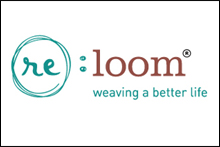
Emory has found a new solution to a disposal problem, a student enrichment opportunity and one more way to reduce the University's carbon footprint using through recycled fabrics.
This summer, Emory's Campus Services donated over 100 pounds of custodial uniforms and Emory Athletics donated over 300 pounds of athletic uniforms to re:loom, a Decatur-based nonprofit that weaves used materials into new products from shredding textiles, such as uniforms.
Re:loom workers weave those materials into a variety of upcycled products — including purses, scarves, checkbook covers, rugs and runners — which are then sold. Proceeds support salaries and health care benefits for re:loom employees, who are homeless, housing-insecure or job-insecure.
By incorporating Emory's discarded uniforms into its products, re:loom not only keeps garments out of local landfills but also helps solve a uniform disposal problem. The nonprofit removes all Emory badges and insignia and returns them to the University.
"We had a major and legitimate security issue with recycling our uniforms because of the Emory brand name on them," said Ciannat Howett, director of sustainability issues at Emory. "We couldn't donate them to the Salvation Army or Goodwill" because of the branding issue.
"This is the first time an organization such as re:loom has approached us and asked for donations," says Jamie McDermott, equipment manager for Emory Athletics. "In the past four years we have done a variety of different things with old uniforms. However, we have never just thrown uniforms in the trash. Honestly, I think the biggest upside to re:loom is that we knew where the uniforms were going as it gave coaches an alternate way to recycle uniforms."
Howett learned of re:loom through her position as chair of the board of Sustainable Atlanta, a group of organizations promoting sustainability throughout the metro area. The Emory-re:loom partnership is featured on the website of Look Up Atlanta, which connects resources with needs in the metro community.
Re:loom is also being viewed as an outlet to "enrich our students' academic lives," says Howett, who recently took student leaders from Greeks Go Green and Volunteer Emory on a tour of the facility.
She sees it as a pathway for student involvement; student internships are in the works. "It's a great example of the way Emory can help outside of the campus gates," Howett said.
The partnership helps build the University's sustainability mission, she adds, pointing out that landfills are a major source of greenhouse gas emission and working with re:loom helps reduce Emory's carbon footprint.
"We're looking at possible ways of being a customer of the end product," Howett says. While re:loom doesn't produce products in the commercial quantity and magnitude that Emory often needs, the University is exploring the possibility of purchasing some of its smaller products, like runners or pillows, she adds.
